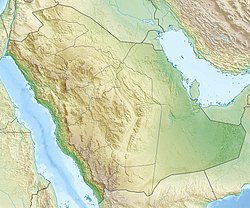Safa and Marwa
| Safa and Marwa | |
|---|---|
Arabic) | |
| Geography | |
| Country | |
| Region | Hejaz |
| Province | Mecca |
| City | Mecca |
| Parent range | Hijaz Mountains |
Safa and Marwa (
.Muslims run between the two mountains, which they believe was made a ritual as a tribute to Hajar's search of water for her child dying of thirst until she found a water source in the Zamzam Well. The space between the two mountains in which the pilgrims run is called al-Mas'aa.[1][3]
Geography
Safa is a small mountain located at the bottom of the Abu Qubais Mountain, about 130 m (430 ft) southeast of the Ka'bah, which is the beginning of the Sa'ee. As for Marwa, it is also a small mountain of white stone, located 300 m (980 ft) to the northeast of the Ka'bah and it is connected to Qaiqan Mountain, marking the end of the Sa'ee. Safa, Marwah and the Masa'a (space between the two mountains) were located outside the Masjid al-Haram and were separate until the year 1955/56 (1375 AH), when the project to annex the two sites into the Masjid al-Haram was undertaken for the first time, and they were subsequently annexed.[1] The distance between Safa and Marwa is approximately 450 m (1,480 ft), therefore, seven trips back and forth amount to roughly 3.15 km (1.96 mi).
History
Geological perspective


The individual geological history of the two mountains is relatively unknown. Marwa has been described as smoother and lighter in color than Safa, with some even calling it white, such as Majd ad-Din Ferozabadi, az-Zubaidi, al-Fayoumi. al-Alusi further went on to say that Safa's color was comparable to a tint of red. Safa and Marwa are a part of the Hejaz mountain range, which run parallel to most of the Saudi coast on the Red Sea. The Hejaz themselves are part of the larger Sarawat range, which is characterized by young and jagged mountains.[4]
Islamic narrative
In
Before Muhammad
The early Ansari Muslims gave up the custom of Sa'ee seeing it as idol worship and shirk and a sign of the pre-Islamic period of ignorance (jahiliyyah). It is in this context that Verse 158 of Surah 2 was revealed (Sahih Bukhari, Vol. 6, Book 60, Hadith 22/23).[7] In another narration by Abdullah Yusuf Ali in his commentary on Verse 2:158, he argues that the verse had been revealed because the pagans of Quraysh had placed two idols atop the two hills and the Muslims felt hesitant to walk between the hills, seeing it as idol worship or as an act of shirk.[8] Anas ibn Malik also said that he felt hatred in walking between the two hills as he saw it as a pre-Islamic custom from the jahiliyyah until Allah had revealed Verse 2:158 (Sahih Bukhari, Vol. 2). Aisha confirmed the verse had been revealed with regards to the Ansar, who said it was sinful to walk between the hills as they used to visit the idol Manat at Qudaid (near Mecca) in the state of Ihram before going about with the rituals of their pilgrimage in pre-Islamic times. Several similar reasons have been given by multiple scholars of Islam, including al-Suyuti in his Asbab an-Nuzul[9] and George Sale in his Preliminary Discourse to the Quran.[10]
Revisionist and source critical views
Tom Holland and Patricia Crone, both revisionist scholars of early Islamic history, suggest that Islam might not have originated in Mecca, but rather someplace to the north, possibly in the Levant. Building on this suggestion, but taking it a step further, Paul Ellis suggests that Islam originated in or near Jerusalem. One of the main pieces of evidence for this theory is his claim that the hills referred to as Safa and Marwa in the Qur'an are actually hills in Jerusalem. According to Ellis, Marwa is Mount Moriah and Safa is Mount Scopus. Ellis notes that Josephus referred to Mount Scopus as Sapha (Σάφα), which is phonetically identical to Safa.[11]
Significance in the Hajj and Umrah
Performing the Sa'ee serves to commemorate Hajar's search for water for her son and God's mercy in answering prayers. Two walkways guide pilgrims from Safa to Marwa, and from Marwa to Safa, with two narrower walkways in the center to serve elderly and
-
The first walkway of the Mas'aa leading from Safa to Marwa
-
Central section reserved for the elderly and disabled
-
The second walkway returning from Marwa to Safa
See also
References
- ^ a b c Hamw, Mahmoud M.; Isa, Abdul Ghani (2019). Makkah Al-Mukarramah: History and Milestones.
- ISBN 0-915957-54-X.
- ^ a b c d "IN PICTURES: The story of a Muslim ritual with roots dating back 5,000 years". Al Arabiya English. 2018-01-06. Retrieved 2020-07-06.
- OCLC 826009050.
- ISBN 978-0-946621-33-0.
- ISBN 0-0606-3126-0.
- OCLC 35673415.
- OCLC 870650664.
- ISBN 9782745184108.
- ISBN 9783337821944.
- ^ d ', Paul D.; Ellis, A. "Jerusalem, City of Islam by Paul D d'A Ellis".
{{cite web}}: CS1 maint: numeric names: authors list (link)









